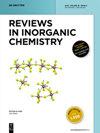Pt(η3-P1X1P2)(Y) (X1 = B, S或Si)和Pt(η3-P1P2Si1)(Y)衍生物中的异三齿有机二膦-结构方面
IF 3.1
3区 化学
Q1 CHEMISTRY, INORGANIC & NUCLEAR
引用次数: 2
摘要
摘要本文综述了近30种Pt(II)配合物,其组成分别为Pt(η3-P1X1P2)(Y)、(X1=BL、SL或SiL)、(Y=H、OL、NL、CL、CL、PL或I)和Pt(ω3-P1P2Si1)(CH3)。杂三齿配体形成六种类型的金属环:P1CNB1NCP2、P1C2S1C2P2、P1C2Si1C2P2(最常见)、P1CNSi1NCP2和具有常见B1、S1或Si1原子的P1C3Si1C3P2。在P1C2P2C3Si1中,P2原子是常见的。分析和讨论了结构数据(Pt–L,L–Pt–L),并注意到Pt(II)原子的正方形平面几何结构的畸变以及反式影响。Pt–L(x4)键距的总和随着X1和Y原子的共价半径而增长。本文章由计算机程序翻译,如有差异,请以英文原文为准。
Heterotridentate organodiphosphines in Pt(η3-P1X1P2)(Y) (X1 = B, S, or Si) and Pt(η3-P1P2Si1)(Y) derivatives-structural aspects
Abstract This review covers almost 30 Pt(II) complexes of the composition Pt(η3-P1X1P2)(Y), (X1 = BL, SL, or SiL), (Y = H, OL, NL, CL, Cl, PL, or I) and Pt(η3-P1P2Si1)(CH3). Heterotridentate ligands form six types of metallocyclic rings: P1CNB1NCP2, P1C2S1C2P2, P1C2Si1C2P2, (most common), P1CNSi1NCP2, and P1C3Si1C3P2 with common B1, S1, or Si1 atoms. In P1C2P2C3Si1 the P2 atom is common. The structural data (Pt–L, L–Pt–L) are analyzed and discussed with an attention to the distortion of a square-planar geometry about Pt(II) atoms as well as trans-influence. The sum of Pt–L(x4) bond distances growing with covalent radius of the X1 and Y atoms.
求助全文
通过发布文献求助,成功后即可免费获取论文全文。
去求助
来源期刊

Reviews in Inorganic Chemistry
化学-分析化学
CiteScore
7.30
自引率
4.90%
发文量
20
审稿时长
1 months
期刊介绍:
Reviews in Inorganic Chemistry (REVIC) is a quarterly, peer-reviewed journal that focuses on developments in inorganic chemistry. Technical reviews offer detailed synthesis protocols, reviews of methodology and descriptions of apparatus. Topics are treated from a synthetic, theoretical, or analytical perspective. The editors and the publisher are committed to high quality standards and rapid handling of the review and publication process. The journal publishes all aspects of solid-state, molecular and surface chemistry. Topics may be treated from a synthetic, theoretical, or analytical perspective. The editors and the publisher are commited to high quality standards and rapid handling of the review and publication process.
Topics:
-Main group chemistry-
Transition metal chemistry-
Coordination chemistry-
Organometallic chemistry-
Catalysis-
Bioinorganic chemistry-
Supramolecular chemistry-
Ionic liquids
 求助内容:
求助内容: 应助结果提醒方式:
应助结果提醒方式:


